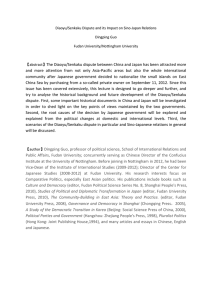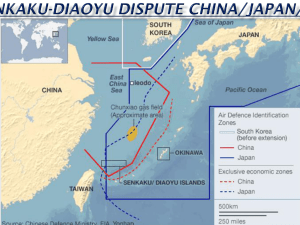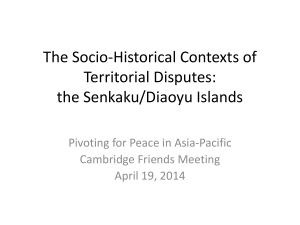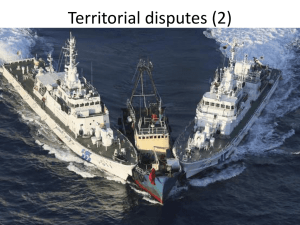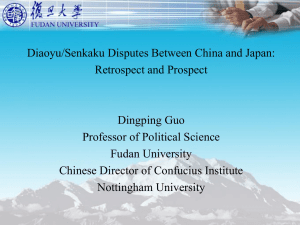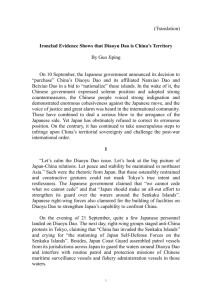Tensions in Sino-Japanese Relations in 2012 and 2013
advertisement
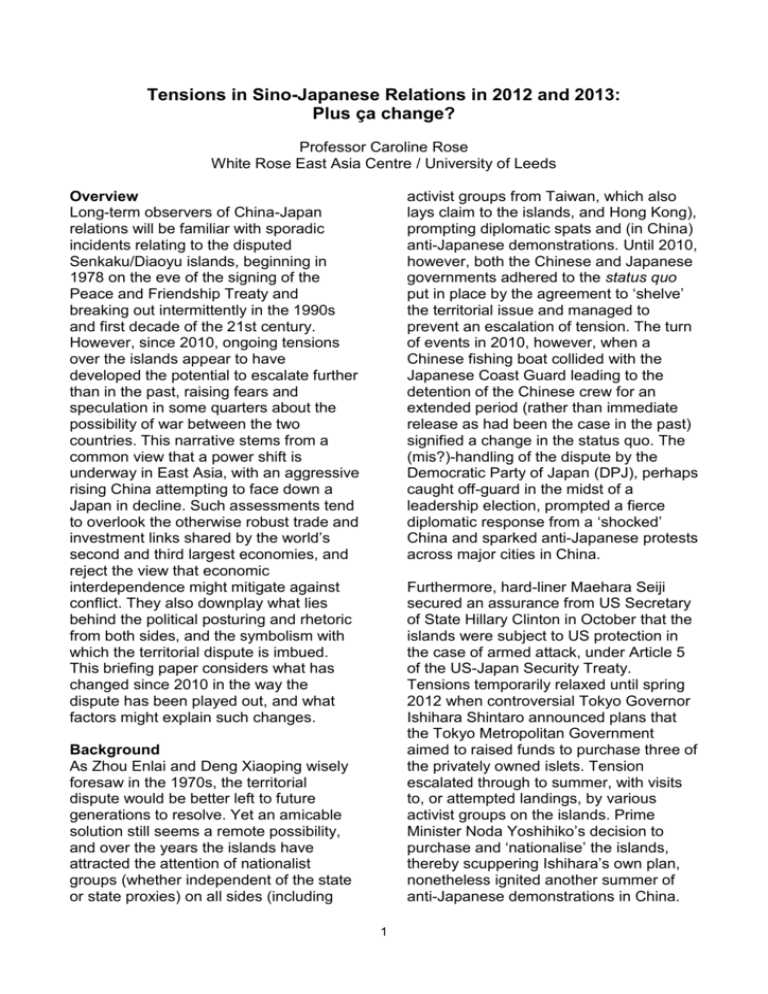
Tensions in Sino-Japanese Relations in 2012 and 2013: Plus ça change? Professor Caroline Rose White Rose East Asia Centre / University of Leeds Overview Long-term observers of China-Japan relations will be familiar with sporadic incidents relating to the disputed Senkaku/Diaoyu islands, beginning in 1978 on the eve of the signing of the Peace and Friendship Treaty and breaking out intermittently in the 1990s and first decade of the 21st century. However, since 2010, ongoing tensions over the islands appear to have developed the potential to escalate further than in the past, raising fears and speculation in some quarters about the possibility of war between the two countries. This narrative stems from a common view that a power shift is underway in East Asia, with an aggressive rising China attempting to face down a Japan in decline. Such assessments tend to overlook the otherwise robust trade and investment links shared by the world’s second and third largest economies, and reject the view that economic interdependence might mitigate against conflict. They also downplay what lies behind the political posturing and rhetoric from both sides, and the symbolism with which the territorial dispute is imbued. This briefing paper considers what has changed since 2010 in the way the dispute has been played out, and what factors might explain such changes. activist groups from Taiwan, which also lays claim to the islands, and Hong Kong), prompting diplomatic spats and (in China) anti-Japanese demonstrations. Until 2010, however, both the Chinese and Japanese governments adhered to the status quo put in place by the agreement to ‘shelve’ the territorial issue and managed to prevent an escalation of tension. The turn of events in 2010, however, when a Chinese fishing boat collided with the Japanese Coast Guard leading to the detention of the Chinese crew for an extended period (rather than immediate release as had been the case in the past) signified a change in the status quo. The (mis?)-handling of the dispute by the Democratic Party of Japan (DPJ), perhaps caught off-guard in the midst of a leadership election, prompted a fierce diplomatic response from a ‘shocked’ China and sparked anti-Japanese protests across major cities in China. Furthermore, hard-liner Maehara Seiji secured an assurance from US Secretary of State Hillary Clinton in October that the islands were subject to US protection in the case of armed attack, under Article 5 of the US-Japan Security Treaty. Tensions temporarily relaxed until spring 2012 when controversial Tokyo Governor Ishihara Shintaro announced plans that the Tokyo Metropolitan Government aimed to raised funds to purchase three of the privately owned islets. Tension escalated through to summer, with visits to, or attempted landings, by various activist groups on the islands. Prime Minister Noda Yoshihiko’s decision to purchase and ‘nationalise’ the islands, thereby scuppering Ishihara’s own plan, nonetheless ignited another summer of anti-Japanese demonstrations in China. Background As Zhou Enlai and Deng Xiaoping wisely foresaw in the 1970s, the territorial dispute would be better left to future generations to resolve. Yet an amicable solution still seems a remote possibility, and over the years the islands have attracted the attention of nationalist groups (whether independent of the state or state proxies) on all sides (including 1 While the demonstrations subsided soon after the usual round of anniversaries was completed (in particular September 18th, which marks the beginning of Japan’s invasion of Manchuria in 1931), the highlevel political posturing on the Senkaku/Diaoyu dispute continued, taken up enthusiastically by the new leadership in both countries. In late 2013 the issue continues to occupy a fairly central space on the diplomatic agenda. The next sections explore what is different about the 2012-13 instalment of the Senkaku/Diaoyu issue, and why this might be. in the sort of behaviour being demonstrated around the Diaoyu islands today. Chinese media reports on the dispute in 2012 and 2013 made direct links with the ‘history problem’, criticising Japan’s official stance on the Diaoyu as representing a denial of the outcomes of the global anti-fascist war (in which the Chinese were victorious alongside the allied powers). In the Japanese discourse, the standard explanation is that there is no territorial dispute, although much effort is expended on providing evidence as to why that is the case, including lengthy accounts (for example on the Japanese Ministry of Foreign Affairs website) of the historical origins of Japanese claims to the islands. The Japanese approach is to remove the issue from the sensitivities of history (that is, Japan's imperialist past) and to deal with it instead from the point of view of international law and security, stressing Japan’s democratic and peaceful credentials. Re-presenting the Territorial Dispute in 2012 One of most striking differences in the 2012-13 instalment of the Senkaku/Diaoyu dispute compared with previous incidents is the way in which the history of the dispute has been recounted to the domestic and international audiences. In the Chinese narrative, the Diaoyu dispute has become firmly embedded into the story of Japan’s imperialist history of invasion. This has not been done to such an extent before, and the Diaoyu dispute has thus been incorporated into one of the other major recurring problems in Sino-Japanese relations – the ‘history problem’. On the other hand, the Japanese official narrative is at pains to completely decouple the history of the acquisition of the islands from Japan’s imperialist past. In both China and Japan, the telling of the Senkaku/Diaoyu story can be seen as a re-nationalising of history; in each case it is an immutable, indisputable story with one, and only one, version. Furthermore it seems to resonate very strongly with the public, and plays well to the sorts of domestic audiences that leaders Abe Shinzo and Xi Jinping are trying to attract, and from whom they gain their legitimacy . These are unifying discourses in each country. In Japan, the ‘traditional’ left-right split, not least on interpretations of the past, disappear into a national consensus on the Senkaku issue. In China, where multiple and contested histories have been emerging in recent years, the Diaoyu ‘story’ becomes a reminder of the Chinese people’s struggle to overcome national humiliation at the hands of the imperialists. In the Chinese discourse, Japan’s capture and illegal occupation of the islands is traced back to the unequal treaty of 1895 (Treaty of Shimonoseki) after the first Sino-Japanese war (1894-1895), from whence a straight line can be drawn through to the second Sino-Japanese war (1937-1945), about which the Japanese do not hold a ‘correct’ view, which is why the Chinese need to remain vigilant about a possible resurgence of Japanese militarism, evidence of which can be seen 2 did not have Hu’s physical support since he had stood down from all senior posts (previous leaders tended to remain in top posts). This in turn meant that Xi had to ensure that he had firm control over all areas of government. This included the need to send strong and clear signals on foreign policy in order to placate the People’s Liberation Army, in addition to having to deal with potentially delegitimising and destabilising legacy problems from the Hu-Wen era (in the form of corruption, social unrest and so on). A tried-and-tested foreign policy issue such as the Diaoyu island dispute was arguably a useful distraction at this point and would enable him to take a strong stance against Japan. Appeals to international audiences have been important in this round of the dispute too, and both sides have attempted to garner support, through the use of international media and proactive public diplomacy for their respective arguments. This marks a shift away from dealing with the dispute as a purely bilateral issue, though the effect such international public relations campaigns seems somewhat limited. The DPJ’s success in bringing a hitherto reluctant US off the fence in 2010 to pronounce on the issue was an important milestone, although Prime Minister Abe did not get the support he was hoping for from President Obama in 2013. The Chinese courted Papua New Guinea in September 2012 and gained their ‘understanding’, but were less successful in securing similar support from Germany during a visit by Li Keqiang in May 2013. Political change was also afoot in Japan with the collapse in support for the DPJ by the summer of 2012, a general election on the horizon and the resurgence not only of the Liberal Democratic Party, but Abe, who took up position once again as prime minister by the end of the year, and had much to prove. Unusually, foreign policy ranked fairly high up the agenda during the election campaign and Abe promised to take a firm stance on the Senkaku issue, not least to contrast the DPJ’s bungled handling of the 2010 instalment. On taking office, Abe adopted a fairly pragmatic position on China (as he had done during his first stint as prime minister), but he remained committed to policies which were clearly aimed at checking China’s rising power (for example, by strengthening the role of the Japan Maritime Self Defense Role to counter China’s naval build up), and remained constant in his assertive tone on China. Mindful of the need to prove himself in the Upper House elections of July 2013, Abe had to ensure not only the success of Abenomics but he also had to remain true to his general election pledges to ‘take back the country’. Political Transitions and Legitimacy Issues Putting aside any economic value and the (slightly separate) issue of gas and oil deposits in the East China Sea, it could be argued that the ongoing tension has considerable political value. Barring the potential for mishap or miscalculation since September 2012 (and of course this can’t be ruled out), the stand-off has not been damaging to, and could be said to have positively enhanced, the domestic political agendas for the leaders in China and Japan in the context of major political transitions in both cases. In the summer of 2012 China was preparing for the handover of power from the Hu Jintao/Wen Jiabao period to Xi Jinping and Li Keqiang ahead of the 18th Communist Party Congress to be held in November. As the Senkaku/Diaoyu dispute developed over subsequent months, Xi Jinping was still building and consolidating his power base. Even though he was Hu’s protégé, which carries a certain amount of authority, he 3 In both countries, the Senkaku/Diaoyu dispute, and its timing in 2012/13 presented certain opportunities for the new leaders to legitimize their positions and build their domestic support base by proving their nationalist credentials. This in turn presents a certain risk or escalation if not managed carefully, but it should be noted that, compared with the 2010 incident, there were much greater dispute management mechanisms in place in 2012 through both informal and formal channels (for example through friendship diplomacy and through Ministry of Foreign Affairs links). Anti-Japanese demonstrations in China, almost a regular feature in the Sino-Japanese calendar, are also of concern. But self-regulation was in evidence in the summer of 2012 where bloggers, and the official media, admonished those who showed the ‘wrong’ sort of ‘irrational’ patriotism. agenda for longer, and both sides have maintained a fairly regular drum beat of high level political rhetoric. This can be explained partly by the need for the new leadership on both sides to consolidate domestic support after a period of political transition. Dispute management mechanisms are in place, but need to be used carefully to avoid any further escalation of tension. Further Reading Phil Deans (2000) ‘Contending Nationalisms and the Diaoyutai/Senkaku Dispute’, Security Dialogue, Vol. 31, No. 1, pp. 119-131. Karl Gustafsson (2013) ‘The Sino-Japanese Battle for Hearts and Minds over the Diaoyu/Senkaku Islands’, East Asia Forum, 13 March. Available online: http://www.eastasiaforum.org/2013/03/13/thesino-japanese-battle-for-hearts-and-mindsover-the-diaoyusenkaku-islands Summary The Senkaku/Diaoyu dispute has long held a symbolic value to nationalists in both countries and has been of sporadic use to the Chinese and Japanese governments at various points from the 1970s to the early 21st century; on the whole, however, both governments had tacitly adhered to the agreements of 1972 and 1978 to shelve the issue for future generations. The nature of the Senkaku/Diaoyu dispute changed in 2010, perhaps as a result of DPJ mishandling, but this has had implications in terms of taking the issue ‘off the shelf’ and producing a recalibration of the positions of both sides. This partly explains the instability of the current situation as a new status quo emerges. The 2012/13 instalment of the Senkaku/Diaoyu dispute is noteworthy because it has remained high on the diplomatic James Manicom and Andrew O’Neil (2009) ‘Sino-Japanese Strategic Relations: Will Rivalry Lead to Confrontation?’, Australian Journal of International Affairs, Vol. 63, No. 2, pp. 213-232. Ming Wan (2011) ‘Sino-Japanese Relations Adrift in a Changing World, Asia-Pacific Review, Vol. 18, No. 1, pp. 73-83. Krista E. Wiegand (2009) ‘China’s Strategy in the Senkaku/Diaoyu Islands Dispute: Issue Linkage and Coercive Diplomacy’, Asian Security, Vol. 5, No. 2, pp. 170-193. Caroline Rose is Professor of Sino-Japanese Relations in the Department of East Asian Studies at the University of Leeds, and Executive Director of the White Rose East Asia Centre. She may be contacted at C.Rose@leeds.ac.uk 4
